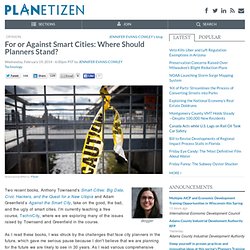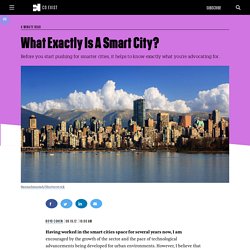

I-Neighbors: free neighborhood website, email forum, social network for your community. Nextdoor: Join the free private social network for your neighborhood. Citizen feedback for the digital age. Design. This guest post is submitted by Mischa Dohler - Chair Professor at King’s College London, Board of Directors at Worldsensing, Distinguished Lecturer at IEEE, Editor-in-Chief, ETT “Smart Cities” – a trendy phrase likely to be hackneyed before even having achieved anything tangible in improving urban living conditions.

Consultants, policy makers, think tanks – they all paint a rosy future for and through these smart cities. However, there are a few of us out there who are actually sweating to make cities smart. Today. What follows, is a review of some of the challenges we face as of the design year 2013, where focus is mainly on the use and deployment of smart city infrastructure rather than social, citizen and many other aspects. Designing smartness into cities requires some major infrastructure upgrade; in a sense we are constructing the brain of the city.
The sales pitch in all three city types is of course very different. 1) Political Cycles: a. 2) Political Decision Taking: a. Www.ericsson.com/res/docs/2013/the-next-age-of-megacities.pdf. Against the smart city (The city is here for you to use) eBook: Adam Greenfield, Nurri Kim. Smart Cities: Big Data, Civic Hackers, and the Quest for a New Utopia: Anthony M. Townsend: 9780393082876: Amazon.com. Urban Research and Design Laboratory. For or Against Smart Cities: Where Should Planners Stand? Two recent books, Anthony Townsend's Smart Cities: Big Data, Civic Hackers, and the Quest for a New Utopia and Adam Greenfield’s Against the Smart City, take on the good, the bad, and the ugly of smart cities.

I'm currently teaching a free course, TechniCity, where we are exploring many of the issues raised by Townsend and Greenfield in the course. As I read these books, I was struck by the challenges that face city planners in the future, which gave me serious pause because I don't believe that we are planning for the future we are likely to see in 30 years. As I read various comprehensive plans for cities, counties and regions, they focus on the reality of today—the way that we act as a society here and now. They don't seem to recognize the vastly different future that is likely to come. And the future that is forecasted rarely considers the role technology will play in reshaping our cities.
What Exactly Is A Smart City? Having worked in the smart cities space for several years now, I am encouraged by the growth of the sector and the pace of technological advancements being developed for urban environments.

However, I believe that the smart-cities movement is being held back by a lack of clarity and consensus around what a smart city is and what the components of a smart city actually are. While some people continue to take a narrow view of smart cities by seeing them as places that make better use of information and communication technology (ICT), the cities I work with (and most of the participants in the #smartchat, a monthly Twitterchat about smart cities held on the first Wednesday of each month) all view smart cities as a broad, integrated approach to improving the efficiency of city operations, the quality of life for its citizens, and growing the local economy.
Later this year, I’ll publish my annual rankings of smart cities here on Co.Exist. Step 1: Create a Vision with Citizen Engagement.